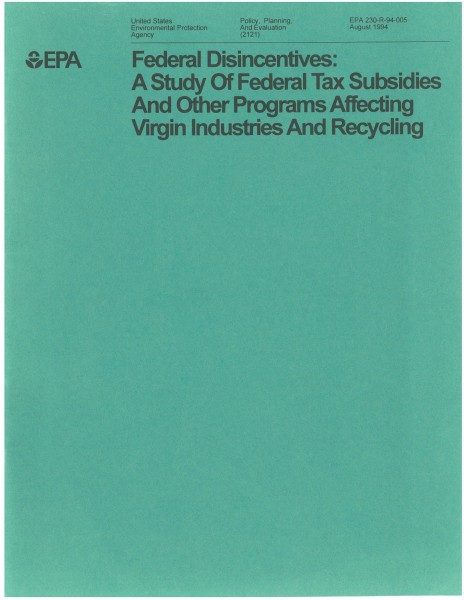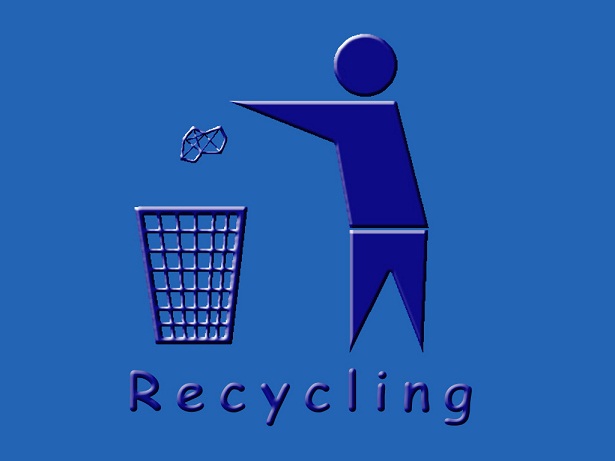The first work I did on environmentally-harmful subsidies was in 1988, and wasn't actually on energy subsidies -- at least not at first. It was an examination of federal government subsidies to primary materials, and whether these subsidies undermined the marketability of secondary materials. Scrap plastic, metal, and paper were starting to pour off of the municipal curside recycling programs that were popping up all over the United States at that time, and the demand side of the equation was still adjusting. Because many secondary materials required much less energy than making them from mined resources, it turned out that the energy subsidies were critical to get a handle on, and became the focus of much of my subsquent work.
During this time period, the US Environmental Protection Agency was addressing recycling and solid waste in many different ways. This particular study, Federal Disincentives: A Study of Federal Tax Subsidies and Other Programs Affecting Virgin Industries and Recycling, was conducted for EPA's Office of Policy, Planning, and Evaluation. I came across the report the other day and decided to scan and post it.[fn]Small fonts in the original mean the scan quality isn't as good as I'd hoped. Increasing the page size in Adobe helps with legibility, and the document is also searchable.[/fn]
I'd forgotten that Terry Dinan was the initial work assignment manager on this paper. She continues to do work on energy subsidies today, though is now with the Congressional Budget Office rather than EPA.
 When I reread the paper, there was much in there I still found useful. An inventory of the many ways the federal government undermined recycling through subsidies to primary industries, as well as the related historical data, is a useful reminder of how long these distortions have existed. Incremental subsidies to primary aluminum over secondary, for example, were estimated to comprise 9-22% of the delivered price of the metal. These types of distortions make a difference, particularly as recovery rates for aluminum in the US have hovered well below optimums.
When I reread the paper, there was much in there I still found useful. An inventory of the many ways the federal government undermined recycling through subsidies to primary industries, as well as the related historical data, is a useful reminder of how long these distortions have existed. Incremental subsidies to primary aluminum over secondary, for example, were estimated to comprise 9-22% of the delivered price of the metal. These types of distortions make a difference, particularly as recovery rates for aluminum in the US have hovered well below optimums.
But twenty years or more is far too long to go without updating data on this important area. The carbon reduction benefits of using secondary materials rather than primary are quite large, as are reductions in many other types of environmental damages.
If I were to redo it, there are some things I would want to bring into more focus now. This includes more detailed coverage of subsidies to disposal technologies that compete with recycling and reuse; putting better numbers on water subsidies; federal support for cogen in massive industrial plants; and state and local subsidies of all types for expanding these facilities and keeping them open.
Tax-favored organizational structures (e.g., master limited partnerships, REITs, private partnerships) used by primary industries would also warrant careful evaluation, as these are increasingly important in the timber, metals, and fossil fuel sectors. And with so many commodities being imported, case studies of foreign subsidies for selected materials flowing into the US would be quite interesting as well.
Worrying trends
In the late 1980s, the focus was on materials recovery and reuse. Resin sorting of plastics, the ability to handle mixed types of paper, and all sorts of other technical problems had yet to be worked out. In the ensuing decades, there have been many improvements in materials recovery; but some important questions are no longer being asked, and should be.
- Energy recovery elevated above recycling. Despite efforts by the mass burn industry to count heat recovery from wastes as "recycling," important value-added is lost when paper or plastic is burned rather than recycled. And when aluminum or glass is not pulled ahead of time, these materials are rendered unrecoverable.
Yet, government agencies (including certainly DOE, but also EPA and USDA) have continued to subsidize energy recovery from waste streams as though it is the highest and best use of these materials. Separation technologies often do not get the same level of support. This is an unfortunate policy detour: I wish EPA had spent as much money on monitoring and improving materials sorting and reuse over the years as they have spent on their Landfill Methane Outreach Program.
Yes, of course landfill gas should be recovered and used for energy instead of being flared. But methane is a regulated pollutant and the full cost of doing so should be paid by landfill operators (and passed on through tip fees).
Yes, WTE may sometimes be useful. But it should never receive subsidies to construction and operation; these help it to outcompete materials recovery. Continuous emissions monitoring should be mandatory, and waste bans on shipping recyclables to WTE facilities need to actually be enforced.
- Subsidies to timber. Decades ago, there were at least three people looking in detail at subsidies to timber -- albeit mostly limited to federal forests. There was Ross Gorte at the Congressional Research Service; Richard Rice, then at the Wilderness Society; and Randall O'Toole, who is now with the Thoreau Institute. But though analysis of subsidies to forestry does not seem to have been done in many years, the issue hasn't gone away. Are timber roads suddenly economic, or did the Forest Service just stop publishing numbers that allow the subsidies to be seen? Hedge funds, private partnerships, tusts, and a variety of other organizational structures own increasing amounts of timberland; it is now considered an important part of endowment and high-net worth portfolios. Yet many of these holding strategies are tax advantaged -- timber REITS, for example; and the focus on investment returns can skew the manner in which farmland it managed in environmentally-harmful ways. Timber aside, there have also been some eggregious subsidies to paper -- primarily the black liquor loophole -- that likely harmed recovered fiber markets as well. It would be useful to freshen the data on this part of the picture.
- Growing scale of commodity producers. Over the past 25 years, there has been tremendous consolidation in commodities production firms. The largest ones span the globe and are savvy political entities -- as good at extracting government support as they are at extracting minerals in many of the markets in which they operate. Incentives for one firm to challenge subsidies to another have also lessened somewhat, as every firm is getting subsidies somewhere, and the firms can be better off turning a blind eye to the issue since they also are at risk from trade cases or subsidy removal. But there remains a strong public interest in understanding these subsidies, and in ensuring that government policies aren't purposefully or inadvertently supporting primary extraction over materials recovery and reuse.
Updating the information
Are you aware of recent or pending working looking at subsidies to WTE and landfilling over recycling; to timber and paper operations; or to metals mining? Please email if you do.



 When I reread the paper, there was much in there I still found useful. An inventory of the many ways the federal government undermined recycling through subsidies to primary industries, as well as the related historical data, is a useful reminder of how long these distortions have existed. Incremental subsidies to primary aluminum over secondary, for example, were estimated to comprise 9-22% of the delivered price of the metal. These types of distortions make a difference, particularly as recovery rates for aluminum in the US have hovered well below optimums.
When I reread the paper, there was much in there I still found useful. An inventory of the many ways the federal government undermined recycling through subsidies to primary industries, as well as the related historical data, is a useful reminder of how long these distortions have existed. Incremental subsidies to primary aluminum over secondary, for example, were estimated to comprise 9-22% of the delivered price of the metal. These types of distortions make a difference, particularly as recovery rates for aluminum in the US have hovered well below optimums. 
